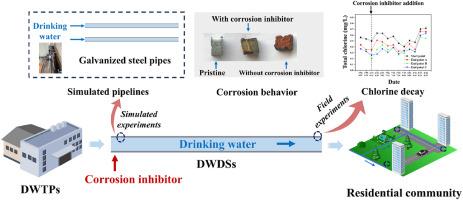复合磷酸盐缓蚀剂对饮用水配水系统腐蚀行为和水质稳定性的影响
IF 8.7
Q1 Environmental Science
引用次数: 0
摘要
在实际工程需求的指导下,研究了复合磷酸盐缓蚀剂在提高饮用水分配系统(dwds)水质稳定性方面的有效性。通过模拟管道和社区规模的现场试验,探讨了一种缓蚀剂对镀锌钢管腐蚀和余氯衰变的影响。结果表明,经过30天的操作,对照组镀锌钢管层中产生了大量氧化铁,而实验组镀锌层基本保持完整。此外,管道表面腐蚀后的余氯衰变速率达到0.091 min−1,添加缓蚀剂后dwds的衰变速率降低了~ 50%。现场实验进一步证明,加入缓蚀剂后,平均总氯衰变量由0.1 ~ 0.4 mg/L降至0.05 ~ 0.2 mg/L,铁的释放得到有效抑制。同时,加入缓蚀剂后群落水的平均浊度稳定在0.15 NTU以下。改善了水质的化学稳定性,对消毒副产物和生物稳定性无显著影响。复合磷酸盐缓蚀剂的使用为控制dwds中的腐蚀和余氯衰变提供了有效的解决方案,从而有助于饮用水的安全管理。本文章由计算机程序翻译,如有差异,请以英文原文为准。

Effects of a composite phosphate corrosion inhibitor on corrosion behavior and water quality stability in drinking water distribution systems
This study investigated the effectiveness of a composite phosphate corrosion inhibitor in enhancing water quality stability in drinking water distribution systems (DWDSs), guided by practical engineering needs. Through simulated pipelines and community-scale field experiments, the effects of a corrosion inhibitor on the corrosion of galvanized steel pipes and the decay of residual chlorine were explored. Results indicated that after 30 days of operation, a large amount of iron oxides was generated in the galvanized steel pipe layer of the control group, while the galvanized layer of the experimental group remained basically intact. Additionally, the residual chlorine decay rate after corrosion of the pipeline surface reached 0.091 min−1, and the decay rate of DWDSs was reduced by ∼50% after the addition of corrosion inhibitor. Field experiments further demonstrated that following the introduction of the corrosion inhibitor, the mean total chlorine decay dropped from 0.1 to 0.4 mg/L to 0.05–0.2 mg/L, and the Fe release was effectively inhibited. Meanwhile, the average turbidity of the water in the community stabilized below 0.15 NTU after adding the corrosion inhibitor. The chemical stability of water quality was improved, and there was no significant effect on disinfection by-products and biological stability. The use of composite phosphate corrosion inhibitor offers an effective solution to control both corrosion in DWDSs and residual chlorine decay, thereby contributing to the safety management of drinking water.
求助全文
通过发布文献求助,成功后即可免费获取论文全文。
去求助
来源期刊

Water Cycle
Engineering-Engineering (miscellaneous)
CiteScore
9.20
自引率
0.00%
发文量
20
审稿时长
45 days
 求助内容:
求助内容: 应助结果提醒方式:
应助结果提醒方式:


